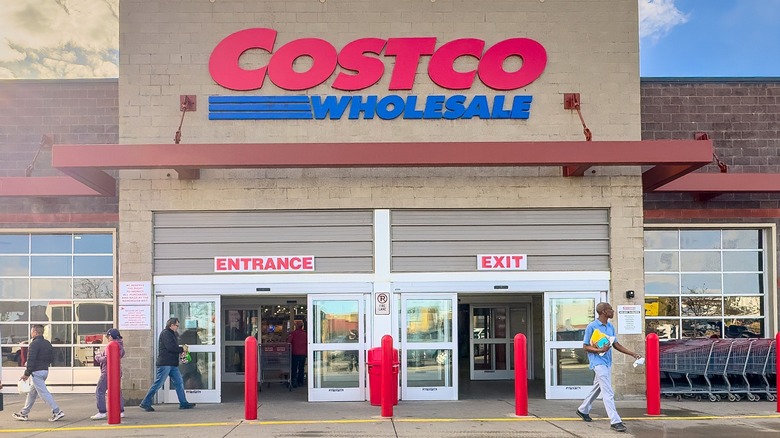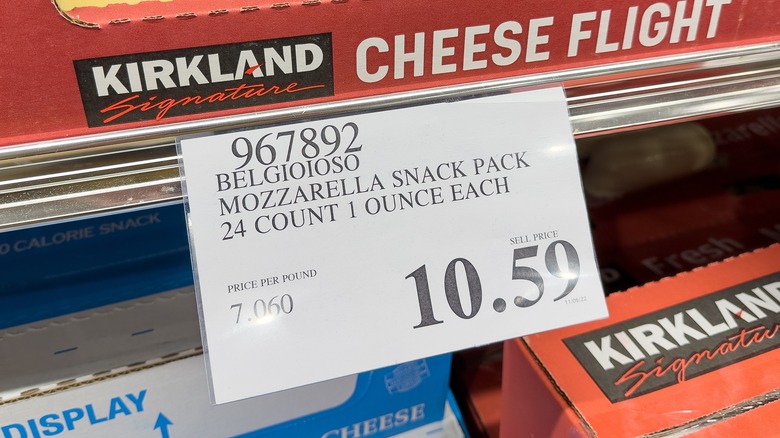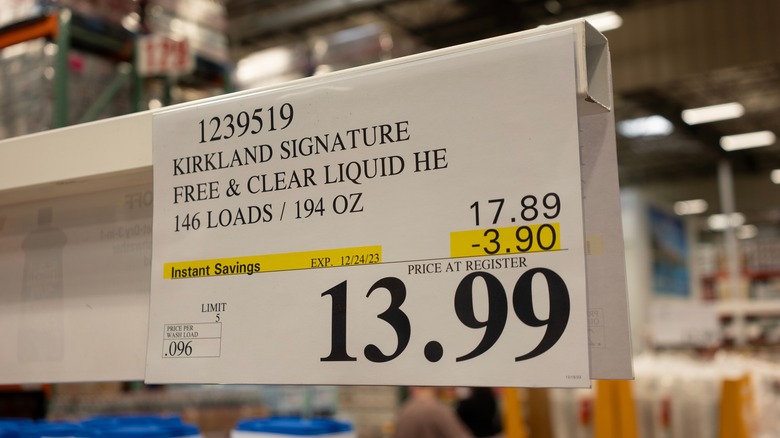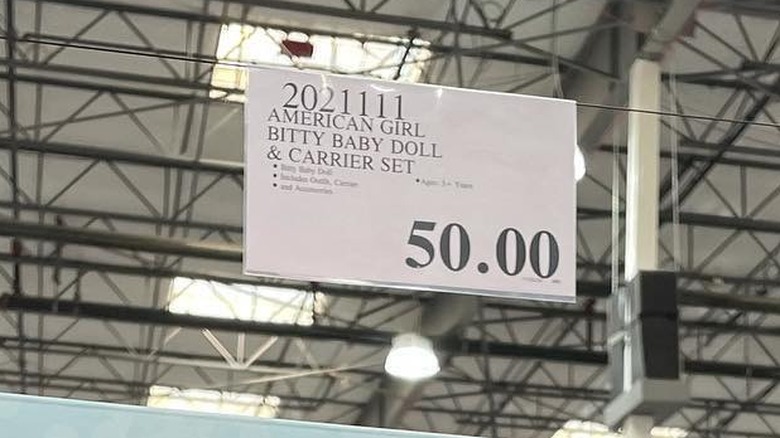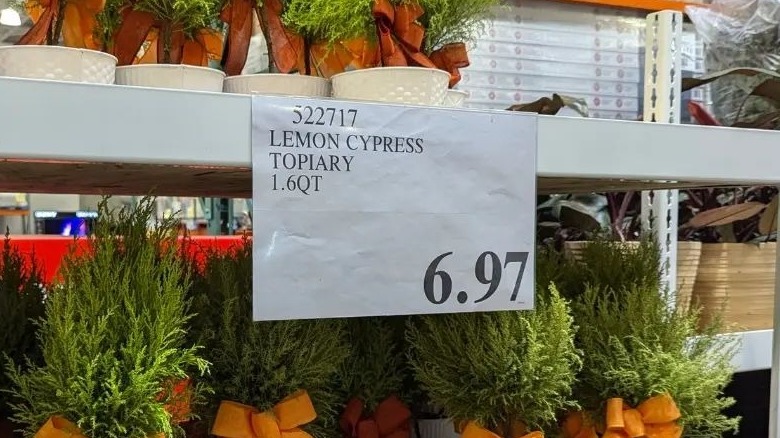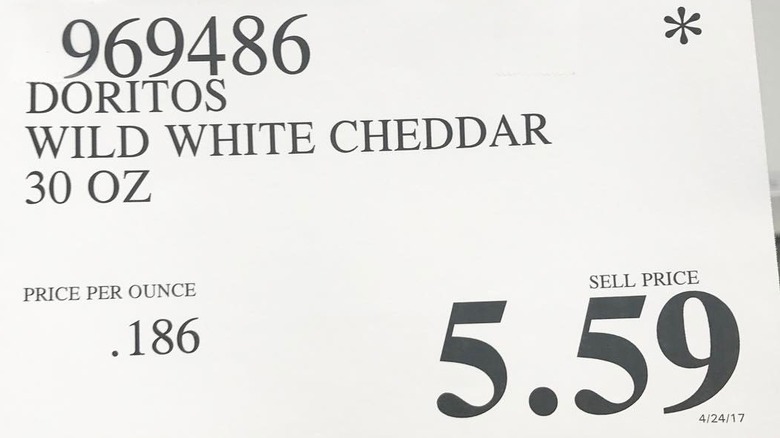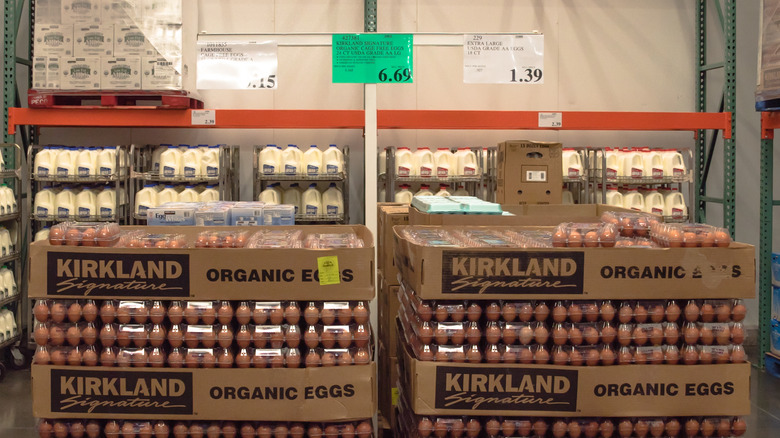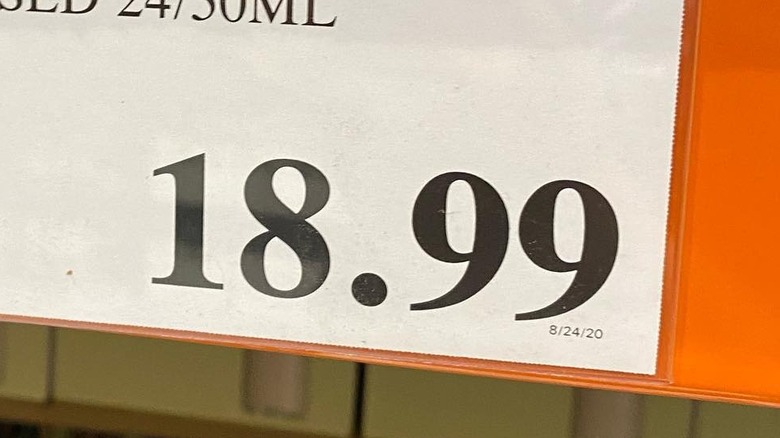Every Costco Price Tag Code, Explained
Come for the 72-pound Parmigiano-Reggiano wheels, stay for the $1.50 hot dog and soda combos. Costco members expect to save big on bulk purchases, house brands, and fill-ups for their gas tanks. But just how deep do those discounts really go? Well, you have to know your price tags.
Costco doesn't label its aisles but it sure does label its items. From Kirkland Signature toilet paper, to 4-pound bags of fish sticks, 50-ounce boxes of cereal, and that XXL teddy bear plushie, each of the warehouse's 4,000 products gets the price tag treatment, complete with the brand's own secret language and semi-unadvertised possibly discount pricing. From the company that made history leveraging zero dollars in sales at its Seattle store opening in 1983, to revenue topping $3 billion by 1989, it's no wonder Costco plays its cards close to the chest.
But we're all here for the deals, so let's start decoding all of the numbers, colors — and one special little symbol — so you can get the most bang for your buck on your next shop. For those who live for the cash register sound formerly known as cha-ching, here's the explanation behind every Costco price tag code.
The Costco tag that ends in a 9
Alas, it appears that any Costco tag that ends in .49, .79, or .89 (or basically anything other than a .99) is merely a sign of standard pricing at the warehouse. But those nines shouldn't take all the wind out of your "sales" because your discount could already be embedded into the printed cost. Ah, don't you just love the smell of price cuts in the morning?
Consumer Reports noted that these odd numbers of cents on the price tag usually indicate that the manufacturer has done a little discounting of its own already — passing some legit savings on to you, lover of Kirkland French vodka and Bulgarian caviar. Fly under the MSRP (Manufacturer's Suggested Retail Price) radar and snap up these low-key discounts when you see them. But keep reading for the heads-up on the tag that ends in .99 (because it means something a little different than these other nines do).
The Costco tag that ends in .99
You definitely don't want to make the mistake of not comparing Costco prices to your local supermarket — and that goes double for items with a price tag ending in .99. As financial influencer Jessica Spangler explained under her Instagram handle @ecommjess, "Standard pricing ends in .99 which is just the regular price that has not been marked down." Boo, Costco, we were hoping for more from this committed relationship.
Digging around for a secret Costco discount, we came up empty handed after several other outlets also showed .99 as being a full price ticket. But while you might be paying top dollar for 4 pounds of Kirkland organic animal crackers, the silver lining is that full priced items will most likely be fully stocked when you hit the snack aisle again next week, too. But wait! If you see it, you want it, and you buy it — and then the price gets marked down after you make your purchase — Costco will make the difference up to you. "I work at Costco," confirmed one TikTok commenter on a post from the user @butthatsmyopinion, adding, "If you buy an item full price within 30 days and we still have the item in the inventory you can price-adjust." Bring the receipts.
The Costco tag that ends in .00 or .88
Almost as thrilling as the sound of the rotisserie chicken bell alerting in-store shoppers to fresh-from-the-oven birds, Costco tags that end in .00 or .88 signal a markdown that you won't want to miss. If only the actual price was $.00
The holy grail of discount tags, these specific double digits signal sales on sales. Whether it's because of an item's low inventory, its status as a former display model, an unfortunate minor flaw, or its reappearance at the store because someone returned it, these markdowns come straight from the manager — and should go right into your cart. You'll most likely find most of the .00 discounts in the apparel section, with .88's shuffled off to the perimeter or end cap displays at the start of each aisle. If you like what you see attached to these tags, make your move because you're probably looking at the last remaining stock.
The Costco tag that ends in .97
It's a markdown, people! Costco tags that end in .97 alert ultra-savvy shoppers like you to a discount also known as a manager's special. But just how "special" that deal might be depends on the day. It could be an itty bitty savings to whet your whistle, or a whopper to lighten the load. Just like the .00 discount hits mostly in the clothing aisles, think of the .97 discount as being related to everything else in the store.
Some of these discounts could be considered blowouts that are designed to clear warehouse shelves (and stock your pantry at home). Just remember that the .97 discount may not be the lowest the price will go (never forget .00). If you've seen Kirkland Signature 4-pound trail mix lingering in a display with the .97 tag for a couple weeks, there's a good chance the price could drop. Feeling lucky? Hold out for a cheaper deal — and try to snatch it up before the item sells out.
The Costco tag with an asterisk (*)
It's never coming back again. Buy it now. This is not a drill. If you've been solely relying on numbers to get the best deals at Costco, there's a punctuation mark that should trigger an all-hands-on-deck response to loading up the cart: the asterisk (*).
With some shoppers calling it the "death star," the asterisk — found in the upper right corner of the price tag — alerts you to a product that's on its way toward being completely out of stock, no matter what numbers are listed with it. This little symbol is the bearer of discount bliss, but if it appears on a product you just can't live without, it's also a dark sign of the cream cheese Danish-less times ahead (not to be dramatic, but maybe now's a good time to stock up on Costco apocalypse food buckets). Hang onto this single shred of hope, however; the asterisk also appears on seasonal items that are destined for a triumphant return next year. Still, if there's no sign of holiday cheer in the vicinity, this (*)'s about to be gone for good.
The green-colored Costco tag
Shopping for something that checks all the boxes on USDA organic? Bright green Costco price tags signal that an item is indeed organic. But while these tags separate the sustainable (green tag) from the conventional (white tag), the system isn't exactly fail-safe. Not every organic item always gets the green tag designation and some warehouses have yet to adopt the practice at all, according to shoppers.
Still, if you do see a green tag on your hummus, ground beef, or quinoa it's gonna be organic. You can also double-check this status by locating the required USDA certified organic icon printed directly on the packaging. Even though Costco offers a variety of organic Kirkland products, shopping organic can cost up to 40% more. Still, it's worth it for members who hope to reduce the pesticides in their foods. You can feel even better about your haul knowing that Costco routinely donates any unsold produce to food banks and others in need.
The little date on the Costco tag
This is some fine print you're gonna want to read. Located in the bottom right corner of the Costco price tag is a date that reveals the last time the item was marked down — and clues you in on when it's due to drop again.
This one's designed to reward those who wait (and also maybe remember to take photos of the dates on the price tags). The date reveals the most recent day that the entire price tag was updated. Maybe you think you're seeing the steepest possible discount, but that might not actually be the case. If your item hasn't been touched in a week or two — and there's no (*) on the tag — you could be in for a pretty fine price reduction in the near future. Now go celebrate your savings with one of those fancy-sliced Costco pizzas in the food court. You earned it.

